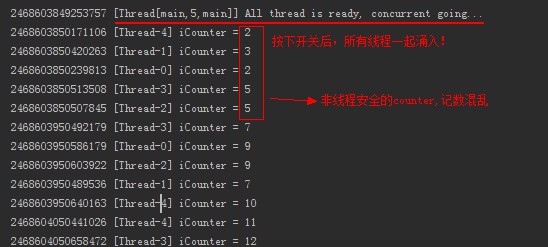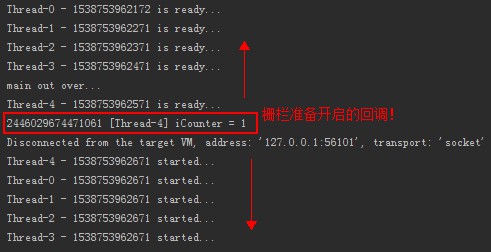(點選上方公眾號,可快速關註)
來源:等你歸去來 ,
www.cnblogs.com/yougewe/p/9745198.html
有時需要測試一下某個功能的併發效能,又不要想借助於其他工具,索性就自己的開發語言,來一個併發請求就最方便了。
Java 中模擬併發請求,自然是很方便的,只要多開幾個執行緒,發起請求就好了。但是,這種請求,一般會存在啟動的先後順序了,算不得真正的同時併發!怎麼樣才能做到真正的同時併發呢?是本文想說的點,Java 中提供了閉鎖 CountDownLatch, 剛好就用來做這種事就最合適了。
只需要:
-
開啟n個執行緒,加一個閉鎖,開啟所有執行緒;
-
待所有執行緒都準備好後,按下開啟按鈕,就可以真正的發起併發請求了。
package com.test;
import java.io.BufferedReader;
import java.io.IOException;
import java.io.InputStream;
import java.io.InputStreamReader;
import java.io.OutputStream;
import java.net.HttpURLConnection;
import java.net.MalformedURLException;
import java.net.URL;
import java.util.concurrent.CountDownLatch;
public class LatchTest {
public static void main(String[] args) throws InterruptedException {
Runnable taskTemp = new Runnable() {
// 註意,此處是非執行緒安全的,留坑
private int iCounter;
@Override
public void run() {
for(int i = 0; i < 10; i++) {
// 發起請求
// HttpClientOp.doGet(“https://www.baidu.com/”);
iCounter++;
System.out.println(System.nanoTime() + ” [” + Thread.currentThread().getName() + “] iCounter = ” + iCounter);
try {
Thread.sleep(100);
} catch (InterruptedException e) {
e.printStackTrace();
}
}
}
};
LatchTest latchTest = new LatchTest();
latchTest.startTaskAllInOnce(5, taskTemp);
}
public long startTaskAllInOnce(int threadNums, final Runnable task) throws InterruptedException {
final CountDownLatch startGate = new CountDownLatch(1);
final CountDownLatch endGate = new CountDownLatch(threadNums);
for(int i = 0; i < threadNums; i++) {
Thread t = new Thread() {
public void run() {
try {
// 使執行緒在此等待,當開始門開啟時,一起湧入門中
startGate.await();
try {
task.run();
} finally {
// 將結束門減1,減到0時,就可以開啟結束門了
endGate.countDown();
}
} catch (InterruptedException ie) {
ie.printStackTrace();
}
}
};
t.start();
}
long startTime = System.nanoTime();
System.out.println(startTime + ” [” + Thread.currentThread() + “] All thread is ready, concurrent going…”);
// 因開啟門只需一個開關,所以立馬就開啟開始門
startGate.countDown();
// 等等結束門開啟
endGate.await();
long endTime = System.nanoTime();
System.out.println(endTime + ” [” + Thread.currentThread() + “] All thread is completed.”);
return endTime – startTime;
}
}
其執行效果如下圖所示:

HttpClientOp 工具類,可以使用 成熟的工具包,也可以自己寫一個簡要的訪問方法,參考如下:
class HttpClientOp {
public static String doGet(String httpurl) {
HttpURLConnection connection = null;
InputStream is = null;
BufferedReader br = null;
String result = null;// 傳回結果字串
try {
// 建立遠端url連線物件
URL url = new URL(httpurl);
// 透過遠端url連線物件開啟一個連線,強轉成httpURLConnection類
connection = (HttpURLConnection) url.openConnection();
// 設定連線方式:get
connection.setRequestMethod(“GET”);
// 設定連線主機伺服器的超時時間:15000毫秒
connection.setConnectTimeout(15000);
// 設定讀取遠端傳回的資料時間:60000毫秒
connection.setReadTimeout(60000);
// 傳送請求
connection.connect();
// 透過connection連線,獲取輸入流
if (connection.getResponseCode() == 200) {
is = connection.getInputStream();
// 封裝輸入流is,並指定字符集
br = new BufferedReader(new InputStreamReader(is, “UTF-8”));
// 存放資料
StringBuffer sbf = new StringBuffer();
String temp = null;
while ((temp = br.readLine()) != null) {
sbf.append(temp);
sbf.append(“\r\n”);
}
result = sbf.toString();
}
} catch (MalformedURLException e) {
e.printStackTrace();
} catch (IOException e) {
e.printStackTrace();
} finally {
// 關閉資源
if (null != br) {
try {
br.close();
} catch (IOException e) {
e.printStackTrace();
}
}
if (null != is) {
try {
is.close();
} catch (IOException e) {
e.printStackTrace();
}
}
connection.disconnect();// 關閉遠端連線
}
return result;
}
public static String doPost(String httpUrl, String param) {
HttpURLConnection connection = null;
InputStream is = null;
OutputStream os = null;
BufferedReader br = null;
String result = null;
try {
URL url = new URL(httpUrl);
// 透過遠端url連線物件開啟連線
connection = (HttpURLConnection) url.openConnection();
// 設定連線請求方式
connection.setRequestMethod(“POST”);
// 設定連線主機伺服器超時時間:15000毫秒
connection.setConnectTimeout(15000);
// 設定讀取主機伺服器傳回資料超時時間:60000毫秒
connection.setReadTimeout(60000);
// 預設值為:false,當向遠端伺服器傳送資料/寫資料時,需要設定為true
connection.setDoOutput(true);
// 預設值為:true,當前向遠端服務讀取資料時,設定為true,該引數可有可無
connection.setDoInput(true);
// 設定傳入引數的格式:請求引數應該是 name1=value1&name2;=value2 的形式。
connection.setRequestProperty(“Content-Type”, “application/x-www-form-urlencoded”);
// 設定鑒權資訊:Authorization: Bearer da3efcbf-0845-4fe3-8aba-ee040be542c0
connection.setRequestProperty(“Authorization”, “Bearer da3efcbf-0845-4fe3-8aba-ee040be542c0”);
// 透過連線物件獲取一個輸出流
os = connection.getOutputStream();
// 透過輸出流物件將引數寫出去/傳輸出去,它是透過位元組陣列寫出的
os.write(param.getBytes());
// 透過連線物件獲取一個輸入流,向遠端讀取
if (connection.getResponseCode() == 200) {
is = connection.getInputStream();
// 對輸入流物件進行包裝:charset根據工作專案組的要求來設定
br = new BufferedReader(new InputStreamReader(is, “UTF-8”));
StringBuffer sbf = new StringBuffer();
String temp = null;
// 迴圈遍歷一行一行讀取資料
while ((temp = br.readLine()) != null) {
sbf.append(temp);
sbf.append(“\r\n”);
}
result = sbf.toString();
}
} catch (MalformedURLException e) {
e.printStackTrace();
} catch (IOException e) {
e.printStackTrace();
} finally {
// 關閉資源
if (null != br) {
try {
br.close();
} catch (IOException e) {
e.printStackTrace();
}
}
if (null != os) {
try {
os.close();
} catch (IOException e) {
e.printStackTrace();
}
}
if (null != is) {
try {
is.close();
} catch (IOException e) {
e.printStackTrace();
}
}
// 斷開與遠端地址url的連線
connection.disconnect();
}
return result;
}
}
如上,就可以發起真正的併發請求了。
併發請求操作流程示意圖如下:

此處設定了一道門,以保證所有執行緒可以同時生效。但是,此處的同時啟動,也只是語言層面的東西,也並非絕對的同時併發。具體的呼叫還要依賴於CPU個數,執行緒數及作業系統的執行緒排程功能等,不過咱們也無需糾結於這些了,重點在於理解原理!
與 CountDownLatch 有類似功能的,還有個工具柵欄 CyclicBarrier, 也是提供一個等待所有執行緒到達某一點後,再一起開始某個動作,效果一致,不過柵欄的目的確實比較純粹,就是等待所有執行緒到達,而前面說的閉鎖 CountDownLatch 雖然實現的也是所有執行緒到達後再開始,但是他的觸發點其實是最後那一個開關,所以側重點是不一樣的。
簡單看一下柵欄是如何實現真正同時併發呢?示例如下:
// 與 閉鎖 結構一致
public class LatchTest {
public static void main(String[] args) throws InterruptedException {
Runnable taskTemp = new Runnable() {
private int iCounter;
@Override
public void run() {
// 發起請求
// HttpClientOp.doGet(“https://www.baidu.com/”);
iCounter++;
System.out.println(System.nanoTime() + ” [” + Thread.currentThread().getName() + “] iCounter = ” + iCounter);
}
};
LatchTest latchTest = new LatchTest();
// latchTest.startTaskAllInOnce(5, taskTemp);
latchTest.startNThreadsByBarrier(5, taskTemp);
}
public void startNThreadsByBarrier(int threadNums, Runnable finishTask) throws InterruptedException {
// 設定柵欄解除時的動作,比如初始化某些值
CyclicBarrier barrier = new CyclicBarrier(threadNums, finishTask);
// 啟動 n 個執行緒,與柵欄閥值一致,即當執行緒準備數達到要求時,柵欄剛好開啟,從而達到統一控制效果
for (int i = 0; i < threadNums; i++) {
Thread.sleep(100);
new Thread(new CounterTask(barrier)).start();
}
System.out.println(Thread.currentThread().getName() + ” out over…”);
}
}
class CounterTask implements Runnable {
// 傳入柵欄,一般考慮更優雅方式
private CyclicBarrier barrier;
public CounterTask(final CyclicBarrier barrier) {
this.barrier = barrier;
}
public void run() {
System.out.println(Thread.currentThread().getName() + ” – ” + System.currentTimeMillis() + ” is ready…”);
try {
// 設定柵欄,使在此等待,到達位置的執行緒達到要求即可開啟大門
barrier.await();
} catch (InterruptedException e) {
e.printStackTrace();
} catch (BrokenBarrierException e) {
e.printStackTrace();
}
System.out.println(Thread.currentThread().getName() + ” – ” + System.currentTimeMillis() + ” started…”);
}
}
其執行結果如下圖:

各有其應用場景吧,關鍵在於需求。就本文示例的需求來說,個人更願意用閉鎖一點,因為更可控了。但是程式碼卻是多了,所以看你喜歡吧!
【關於投稿】
如果大家有原創好文投稿,請直接給公號傳送留言。
① 留言格式:
【投稿】+《 文章標題》+ 文章連結
② 示例:
【投稿】《不要自稱是程式員,我十多年的 IT 職場總結》:http://blog.jobbole.com/94148/
③ 最後請附上您的個人簡介哈~
看完本文有收穫?請轉發分享給更多人
關註「ImportNew」,提升Java技能

 知識星球
知識星球